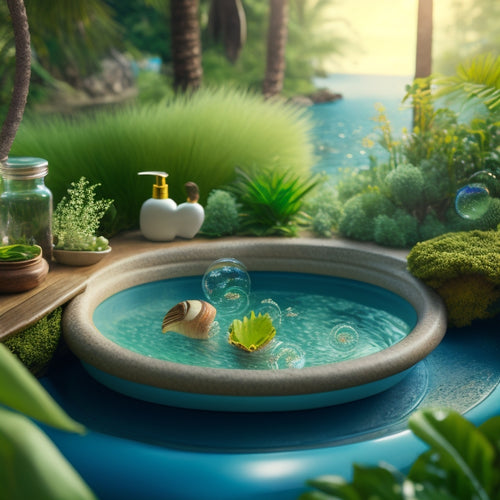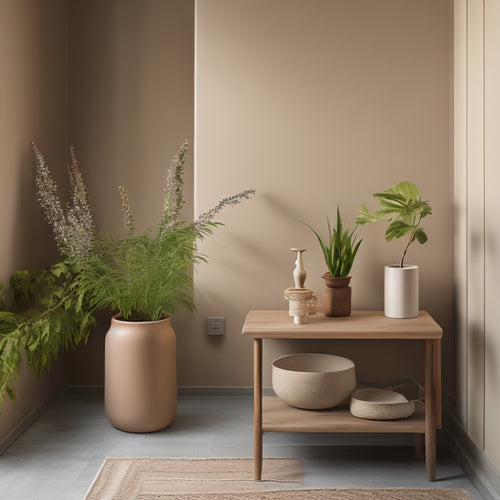
Why Conserve Water With Drought-Proof Gardens?
Share
You're likely living in a drought-prone region where water scarcity is a harsh reality, making it essential to adopt water-conserving strategies like drought-proof gardens that minimize your environmental footprint. By incorporating drought-resistant plants, efficient irrigation systems, and sustainable landscaping practices, you can markedly reduce your water consumption. Effective soil management, rainwater harvesting, and smart irrigation systems can also help alleviate the pressure on groundwater resources. As you implement these strategies, you'll not only conserve this precious resource but also create a thriving garden that's better equipped to survive the challenges of drought - and that's just the beginning of your expedition towards a more sustainable future.
Key Takeaways
- Conserving water with drought-proof gardens reduces overall water consumption and supports ecological gardening with a lower environmental footprint.
- Drought-resistant plants with adaptations like deep roots and waxy leaves require minimal watering, reducing the strain on groundwater resources.
- Efficient irrigation system design and technology, such as smart irrigation systems and moisture sensors, minimize water waste and promote sustainability.
- Sustainable landscaping practices, including the use of native plants and renewable energy sources, reduce water consumption and lower carbon footprints.
- Effective water conservation in drought-proof gardens leads to thriving plants, lower water bills, and a reduced reliance on fossil fuels.
Understanding Drought-Prone Regions
Drought-prone regions, characterized by low rainfall and high evapotranspiration rates, are areas where water scarcity is a recurring issue.
You'll find these regions often have limited groundwater resources, making conservation essential.
To adapt to these conditions, you'll need to focus on climate adaptation strategies that prioritize efficient water use.
With the help of renewable energy solutions, such as solar panels and wind energy, you can reduce your reliance on fossil fuels and conserve water.
Soil management plays a vital role in this process, as it can help reduce evapotranspiration and retain soil moisture.
By implementing effective soil management techniques, you can create a more resilient garden that's better equipped to withstand drought conditions.
This, in turn, allows you to conserve water and protect your garden's ecosystem.
Benefits of Drought-Resistant Plants
Selecting plants that can thrive in arid conditions is an essential step in creating a drought-proof garden.
You'll want to choose drought-tolerant flora that require minimal watering, reducing your water consumption and conserving this precious resource.
By incorporating these plants into your ecological gardening approach, you'll not only save water but also reduce your environmental footprint.
Drought-resistant plants have adapted to survive in dry conditions, often with deep roots or waxy leaves that prevent water loss.
This means you'll spend less time and money on maintenance, enjoying a lush, thriving garden without the guilt of excessive water usage.
Additionally, incorporating green roofs sustainable station designs into your garden can further reduce your carbon footprint.
Efficient Irrigation System Design
Designing an efficient irrigation system is essential to minimizing water waste and ensuring your drought-proof garden receives the right amount of moisture. By choosing the right irrigation methods, you'll conserve water and reduce your environmental impact.
| Irrigation Method | Water Efficiency | Suitability for Drought-Proof Gardens |
|---|---|---|
| Drip Irrigation | High | Ideal for supplying water directly to roots, reducing evaporation |
| Rainwater Harvesting | High | Great for collecting and storing rainwater for irrigation |
| Sprinkler Systems | Low | Less efficient due to water loss through evaporation and runoff |
Water Conservation Through Technology
By leveraging advances in technology, you can markedly enhance water conservation in your drought-proof garden.
Smart irrigation systems, which employ real-time weather data and soil moisture levels, optimize water distribution. Moisture sensors embedded in the soil detect when plants need watering, reducing overwatering and waste. These sensors can be connected to your smartphone, allowing you to monitor and adjust irrigation schedules remotely.
By automating irrigation, you can guarantee your plants receive the right amount of water at the right time. This precision approach minimizes water loss, reduces your water bill, and gives you peace of mind.
Moreover, by reducing our reliance on fossil fuels Renewable Energy and promoting sustainability, we can create a cleaner, healthier environment.
With technology on your side, you can enjoy a lush, thriving garden while conserving this precious resource.
Sustainable Landscaping Practices
Three key principles form the foundation of sustainable landscaping practices: reducing, reusing, and recycling.
You can reduce your water consumption by selecting native plants that thrive in local conditions, minimizing the need for irrigation. Native plant selection also reduces the need for fertilizers and pesticides, which can contaminate waterways.
By incorporating renewable energy sources, such as solar power integration, into your landscaping, you can further reduce your carbon footprint. Additionally, energy storage systems can stabilize the grid, ensuring consistent power supply for irrigation systems.
You can reuse materials like compost and mulch to improve soil health and reduce waste. Recycling rainwater and greywater also reduces the demand on potable water sources.
Effective soil moisture management is critical, and you can achieve this through proper soil preparation, efficient irrigation systems, and regular monitoring.
Frequently Asked Questions
Can I Still Have a Beautiful Garden With Drought-Resistant Plants?
You can still have a stunning garden with drought-resistant plants, offering impressive aesthetic appeal through thoughtful plant variety selection, like succulents, yucca, and lavender, which thrive in dry conditions, ensuring your outdoor space remains beautiful and resilient.
Will Drought-Proof Gardens Attract Fewer Bees and Butterflies?
As you cultivate a drought-proof garden, it's like painting a magnum opus - every brushstroke matters. You'll attract a diverse array of bees and butterflies if you choose plants that cater to their pollinator preferences and provide habitat diversity, ensuring a thriving ecosystem.
Do Drought-Resistant Plants Require Less Maintenance Than Traditional Plants?
You'll find that drought-resistant plants require less maintenance than traditional ones, thanks to their adapted traits; by choosing wisely, you'll reap the drought benefits, enjoying a low-fuss garden that thrives with minimal care, freeing you to focus on what matters most.
Can I Use Rainwater Harvesting Systems for Non-Potable Purposes Only?
Like a treasure chest, rainwater harvesting systems overflow with benefits, and you can tap into them for non-potable purposes, using techniques like rooftop collection and tanker storage, to irrigate your garden, wash cars, or even flush toilets, liberating you from municipal supplies.
Are Drought-Proof Gardens More Expensive to Install Than Traditional Gardens?
When you install a drought-proof garden, you'll likely face higher upfront installation costs, but don't let that deter you - you'll reap long-term savings from reduced water consumption and lower maintenance needs, giving you the freedom to enjoy your garden guilt-free.
Related Posts
-

Why Choose Recycled Paper for Earth-Conscious Business?
By choosing recycled paper, you'll greatly reduce your business's environmental impact. You'll lower your carbon foot...
-

Why Biodegradable Dish Soap Matters for Earth-Conscious Homes
You likely don't realize that the dish soap you're using today will still be harming the environment long after you'v...
-

What Are Natural Clay Paints for Green Home Interiors?
You're about to uncover a game-changing alternative to synthetic paints that not only enhances the aesthetic of your ...


